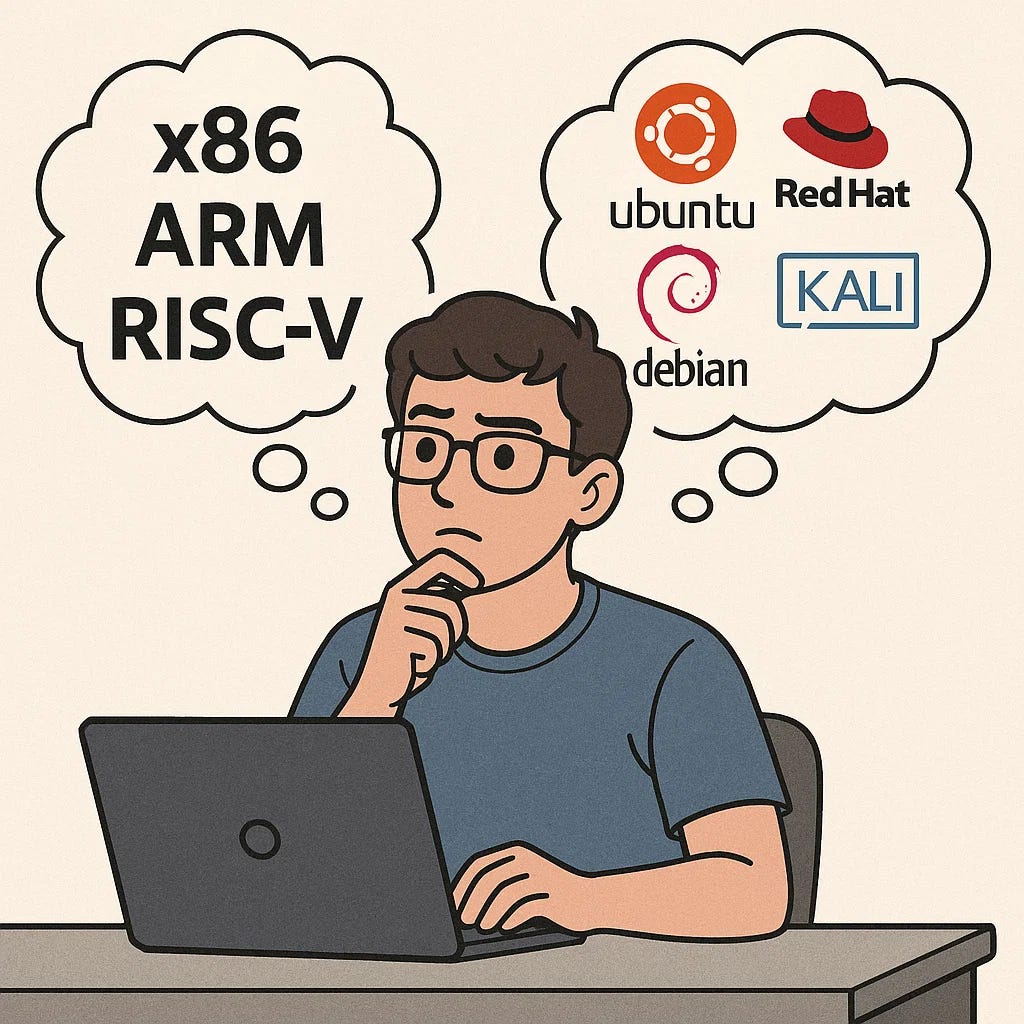So, you’re thinking about using Linux — nice! But the moment you start looking into it, you’re hit with weird words like “x86_64” or “dpkg” or “RISC-V,” and your brain starts buffering.

Don’t worry. Let’s make it super simple — no tech jargon overload, just straight-up clarity.
🤔 Why Should You Care?
If you’re new to Linux or just curious about what system fits your needs, understanding these basics will:
- Help you pick the right version of Linux for your device or project.
- Make sure your system runs smoothly and efficiently.
- Avoid frustration by choosing the correct architecture and distribution combo.
- Give you confidence to dive into Linux without second-guessing everything.
Whether you’re reviving an old laptop, building a home server, or trying ethical hacking, this guide will help you choose smart.
🏗️ Step 1: Understand Your System’s Architecture
Before we talk about Linux versions (aka distributions), you need to know what type of computer you’re working with. Architecture is basically how your computer’s CPU is built and how it processes data.
🧱 Common Architectures
x86 (32-bit)
- Processes 32 bits (or 4 bytes) at a time.
- Common in older computers from the ’90s and early 2000s.
- Still found in ancient school PCs and really old laptops.
- Good for light tasks, but limited on RAM and speed.
x86_64 / AMD64 (64-bit)
- Introduced by AMD, later adopted by Intel.
- Can handle much more memory and faster processing.
- Standard in most modern PCs, laptops, and servers.
- Great for multitasking, gaming, editing, and heavy work.
ARM64 / AArch64
- Known for power efficiency and small footprint.
- Found in devices like Raspberry Pi, smartphones, and embedded systems.
- Perfect when you want Linux on something tiny or low-power.
RISC-V
- Open-source architecture — meaning free to use and modify.
- Newer and used in edge devices, AI accelerators, and experimental boards.
- Not common yet, but growing fast in the Linux world.
🧪 Step 2: Pick Your Linux Distribution (aka Flavor of Linux)
Linux is like pizza — the base is the same, but toppings (features, packages, design) vary depending on who made it.
These versions are called distributions (or distros). They all use the Linux kernel, but offer different tools, user interfaces, and package managers.
🧩 Two Major Types of Linux Distributions
1. RPM-based Distros
(Red Hat Package Manager)
- Examples: Fedora, CentOS, OpenSUSE, Red Hat Enterprise Linux (RHEL)
- Use
.rpmpackages and tools likednforyum - Example command:
dnf install spotify - Mostly used in enterprise environments due to stability, support, and security.
- RHEL is subscription-based, known for patch cycles and long-term support.
2. Debian-based Distros
(DPKG System)
- Examples: Ubuntu, Kali Linux, Linux Mint
- Use
.debpackages and tools likeaptordpkg - Example command:
apt install chrome - Easier for personal use, laptops, or learning.
- Ubuntu is one of the most user-friendly and popular distros — great for beginners.
- Kali is more advanced — built for cybersecurity, with tons of pentesting tools pre-installed.
- Mint is great if you want a more Windows-like feel with a Linux heart.
🎯 Final Thoughts
The best Linux system for you depends on:
- Your device (old, modern, low-power, etc.)
- Your goal (learning, development, cybersecurity, casual use)
- Your comfort with technology
If you’re just getting started, go with Ubuntu on a 64-bit machine. It’s stable, user-friendly, and has loads of support online. If you’re doing something more specific (like setting up a Raspberry Pi), go ARM-based with a lightweight distro. And if you’re running enterprise services, an RPM-based distro like CentOS or RHEL might be the move.
✅ TL;DR

- Architecture first, distro second. Know your hardware: 32-bit (x86), 64-bit (x86_64), ARM, or RISC-V.
- x86_64 is the standard for modern devices.
- RPM-based distros (like RHEL, Fedora) are great for enterprise.
- Debian-based (like Ubuntu, Mint, Kali) are more beginner-friendly.
- Use apt or dnf to install packages — they handle dependencies for you.
- Choose based on what you want to do: learn Linux, build, tinker, or run servers.